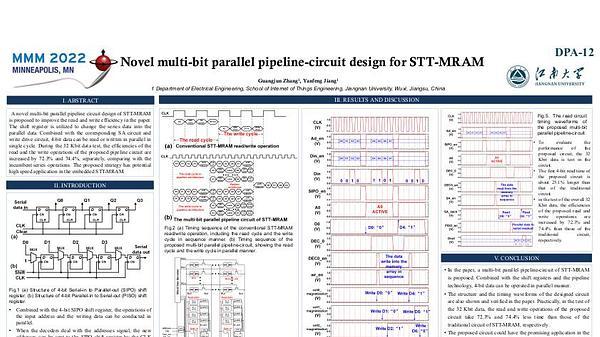Would you like to see your presentation here, made available to a global audience of researchers?
Add your own presentation or have us affordably record your next conference.
Spin-transfer-torque magnetic random-access memory (STT-MRAM) is one of the promising emerging memory technologies as it offers high speed and non-volatility required for embedded applications such as SOCs, IOTs, and Microprocessors (1).However, due to the magnetic nature of the STT-MRAM, the free layer of the memory cell is sensitive to the external magnetic field and the thermal fluctuation (2). For the practical application scenarios of STT-MRAM, the memory may be exposed to high external magnetic field for short time. In this way, high immunity is required for the STT-MRAM memory to avoid any possible data errors caused by the external magnetic field.
In the paper, the memory model at array level is established to study the immunity property of STT-MRAM. By investigation on the magnetic field distribution of the memory array under different external magnetic field, the three operation modes, including standby, active read and active write modes, are simulated and analyzed. Based on the simulation results, the immunity property and the reliability of the memory array is discussed and optimized.
The paper is organized as follows. Firstly, the STT-MRAM array model is established in the HFSS. The magnetic field distribution in the memory array is simulated. The influences of the key geometrical parameters on the magnetic distribution, including the thicknesses of the epoxy and the electrode layer, are investigated. Secondly, to improve the immunity property of the memory, the approach of adding high permeability magnetic shield material is proposed in the paper. Thirdly, the influence of the magnetic immunity on the data reliability of the memory is investigated. The reliability is basically all about data retention and it is determined by effective Eb (3). And the bit error rates (BERs) of the MTJs under the states of standby, active read and active write, are also analyzed in the paper.
Fig.1 The established array model of the STT-MRAM for the immunity investigation. (a) The magnetic field distribution of STT-MRAM array. (b) The magnetic distribution in single STT-MRAM cell.
References:
(1) B. Bhushan, L. T. Guan, D. Shum et al., 2018 IEEE International Memory Workshop (IMW), p. 1-4, (2018).
(2) S. Srivastava, K. Sivabalan, J. H. Kwon, et al. Applied Physics Letters, 114(17):172405. (2019).
(3) T. Y. Lee, K. Yamane, L. Y. Hau, et al. 2020 IEEE International Reliability Physics Symposium (IRPS). p. 1-4 (2020).

